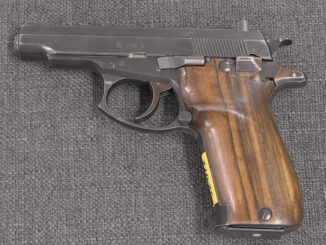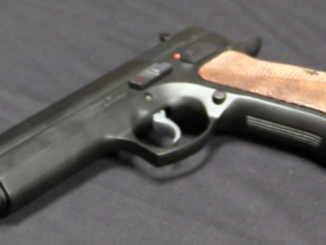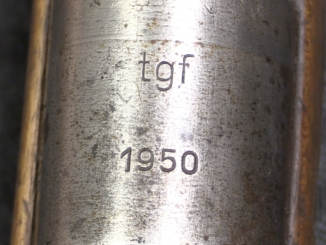Like most other nations with modern military forces. Czechoslovakia was interested in developing a semiautomatic infantry rifle in the 1920s and 1930s. The most successful such rifle to come out of Czech factory during this time was The ZH-29, but it did have competition. A major series of trials was held in 1937 and 1938, and the CZ entrant was this Model 38 rifle.
It uses a tilting bolt with many similarities to the ZB-26 light machine gun and ZH-29 rifle, along with a short stroke gas piston. Interestingly, its charging handle is designed to mimic the manual of arms of the then-standard Mauser bolt action rifles – the handle must be rotated 90 degrees up before pulling the bolt back, and then rotated back down before firing. The CZ model 38 also used a fixed 10-round magazine fed by stripper clips instead of a detachable box magazine.
The model 38 apparently did not do well in the adverse conditions testing. None of the other rifles in the trial were good enough to be judged adequate, though, and more development and trial continued afterwards. The rifle ultimately chosen used an annular gas piston, but was never put into production because of World War II. That design would reappear after the war and lead to the vz.52 rifle.




“its charging handle is designed to mimic the manual of arms of the then-standard Mauser bolt action rifles – the handle must be rotated 90 degrees up before pulling the bolt back, and then rotated back down before firing.”
Similar solution was in G41(M):
http://world.guns.ru/rifle/autoloading-rifles/de/g41-m-e.html
Now I wonder: was it caused by this rifle or it is only accident?
Also some SMGs, like the Bergmann…
Quess the thinking is the handle should be locked to prevent accidental pulls on the bolt… or its just plain designer inertia.
I think logic is that soldier trained with usage of bolt-action rifle will no mess up with his rifle when manual cycling is needed.
Yes, but that seems rather trivial. Walther proved that having the coconut effect of a turn-bolt charging handle for manual cycling was completely unnecessary. While the charging handle doesn’t reciprocate with the bolt (and I think that’s a good thing), having more complications with said charging handle (such as having the rear sight move with the whole manual bolt carrier assembly) does nothing to help the user!
Having the trigger function as the bolt release makes sense if you’re always pointing your main long arm down range. That means if you’re doing things by the book, there is never a time when letting the bolt get back into battery ever endangers the drill sergeant. Judging by general positioning, there is no danger of getting a Garand thumb, though having a battle-crazed itchy trigger finger is more likely to waste one round pointed away from your friends (assuming that you are in battle and not showing off during down time), which is still better than having shot your friend in the kneecap while showing off or worse getting bayoneted to death while fingering a bolt-release button.
Did I mess up?
“Walther proved that having the coconut effect of a turn-bolt charging handle for manual cycling was completely unnecessary.”
In fact it should be quite obvious after looking at any sub-machine gun with simple cycling method.
Agreed. A possible extension of this same logic pertains to the fact that this time period probably marked the point at which greater momentum was gathering for a switch to semi-automatic infantry rifles among many industrialized nations, but it was also recognized that the average soldier was steeped in the technique of manually cycling a bolt-action rifle. I am guessing that, by mimicking the travel path of a standard bolt action upon initial cocking, the designers may have been hoping to make the transition to a semi-automatic rifle just a little more familiar and user-friendly.
They switch to mauser(from straight pull mannlicher) less than generation before, so it would be helpful only to youngest conscripts.
My thought is how much reference viewing they had chance to do those days; probably not much. Thus, they ‘invented’ all and everyone fresh from scratch biting thru the same hurdles. Result was stumbling and inefficiency and prototypes were not ready for serious consideration.
These days, anyone who wishes to design a rifle, goes out to internet, gun shows and patents (and in States of course to range) and have complete review. Based on that he can optimise his design to almost guaranteed result.
I’d just simply call it a progress.
Good call, and I largely agree — although there is still some uncertainty, even with all the informational tools available today, with the question of “market timing”, bad or otherwise :).
To find application for military firearm design is exceedingly difficult, but as up to so far market in US indicates, large number of manufacturers find application of their products on civilian market. Many are of staple such as AR15 type, but some are extremely innovative, such as latest Keltech’s down-ejecting bullpup.
“Many are of staple such as AR15 type”
Now I’m wondering: does 80-20 rule apply also here? In this case it would be:
80% of fire-arms produced is patterned after know models, when 20% of them is something novel
Make it 90/10 and you will be still on optimistic side. Without nuances of unmanageable proportions we both know, there is not much space in this territory for future progress.
However, among limited number of possibilities is a novel approach (or rather revised) to new ammunition concept (no, not “LWS”, neither “caseless”). There is some lead into it in one of TFB recent articles.
I could have been more specific:
http://www.thefirearmblog.com/blog/2016/08/29/future-firearms-ammunition-technology-003-sabots-performance-enhancing-shoes-bullets/
Look at this line:
“Also, a chambering could be made such that it was compatible with both saboted small-caliber bullets, and bore-riding large caliber subsonic projectiles, potentially giving future ammunition both the good trajectory…” (the key being suitable rate of rifling)
In short this is about combining small caliber saboted projectile with full bore heavier (and slower) ones. I mentioned in recent past something in that sense (cannot recall the article; EON was the only one who responded.
“small-caliber bullets, and bore-riding large caliber subsonic projectiles”
But then you need 2 different sights – one for high-velocity and one for slow and also be aware which is in chamber.
“even with all the informational tools available today, with the question of “market timing”, bad or otherwise :).”
Agree. In fact even some clients themselves don’t know or don’t know exactly what they want.
“In fact even some clients themselves don’t know or don’t know exactly what they want.”
Exactly: you hit nail on its head!
True. There is also the political imperative of countries with a relatively limited industrial base trying to make every single part of the firearm in-country (# Independence!). That will drive design and material choices, not always toward an ideal outcome. Then, if you can leap that hurdle, we arrive at the letting of a government contract. “Government Contract” being a Latin phrase meaning “Slicing up the cake so everybody gets a slice.” Again, rarely moving the project toward that ideal outcome.
Wafa Wafa, Wasara Wasara.
Your observations reminded me once more, in a most relevant way, of the controversy surrounding the INSAS rifle. That particular topic is still hotly debated in many circles even today.
“Government Contract” being a Latin phrase meaning “Slicing up the cake so everybody gets a slice.”
I’ve to laugh at this…. perfect description of reality. Yes, been there, seen it.
“gun shows”
BTW this is how von Mannlicher started:
https://en.wikipedia.org/wiki/Ferdinand_Mannlicher
In 1876 he travelled to the Centennial Exposition in Philadelphia to study numerous construction designs and afterwards drafted several types of repeating rifles with tubular magazines.
He was apparently one of the brighter ones. Not necessarily by his own genius but that he was able to pick up cues from others.
“Thus, they ‘invented’ all and everyone fresh from scratch biting thru the same hurdles. Result was stumbling and inefficiency and prototypes were not ready for serious consideration.”
The main problem was that it need to be reasonable-priced and working in all field conditions rather than self-loading – self-loading were produced as early as early 20th century but they lacked reliability or were expensive or both.
You seem to be thinking as a modern ‘market oriented man’. Do you think this was criteria in (presumably) your country when SVT-38/40 was implemented? Yet, this gun was heavily influential (its gas mechanism) to this very day.
“SVT-38/40”
SVT-38 was expensive to make, AVS-36 was much cheaper. Simonov design has it flaws, but they can be deleted. After trials of improved Simonov design and Tokarev design there were group believing in Simonov and group believing in Tokarev. Finally to avoid further delays Stalin supported Tokarev, which as a designer has big experience, when Simonov was newcomer.
Interesting. So, the AVS-36 had some development potential left when the design was actually being manufactured. By the way, can you please tell us if the relative merits/disavantages of both AVS-36 and SVT-38 are discussed in the recent book by Ruslan N. Chumak on the Tokarev rifles?
I have just gotten into reading of article on Valka.cz(unfortunately not in English) which talks of development of rifles models CZ37, CZ38 and 39. The first of these was offered to USSR and was tested there. The subject of article is Jan Kratochvil, one of renown Czech designers (started with weapons and transited lately onto motorcycles).
The last model, according to article was with annular gas piston which idea was utilised in model CZ52. One detail worth of noting is that the label on rifle (in trunion area) says: CESKA ZBROJOVKA A.S. V PRAZE. However, the actual R&D, prototyping and production was done in South-Czech Weapon Factory (Jiho-ceska zbrojovka) in town of Strakonice. They were involved with firearms till early 70s of last century.
Denny,
sorry for going slightly OT
What was the ownership of Brno, CZ etc works?
were they state owned
private stock companies
consortiums of several traditional gun smithing businesses – in order to compete for big orders
or a mixture of some or all of those.
Hi Keith,
as this part of history is not exactly clear to me to every detail, I tell you what I know for certain. The mentioned factory (as a division of enterprise engraved on receiver) was indeed placed in southern part of country. Yes, the origins were in Prague, early days, but later the capacity was transferred to Strakonice including R&D.
Zbrojovka Brno was separate entity with first priority repair and lately building new rifles and mainly machine-guns. They were both privately owned with strong government ‘vested interest’. Probably nothing that surprising. Also, nothing that surprising is that Czech armaments industries were after WWI in enviable position since they were NOT under sanctions such as defeated Germany. To some degree, they ride this reputation to this day.
Even if you weren’t sure which mother the gun was out of – I think it’s fairly obvious who the father was… 😉
and that’s without mentioning any of Diana, Princess of Wales’zzzzz offspring.
All of those family features popping up – the style of the machining, the finish, that straight shanked bolt handle with the drilled ball on the end that is identical to a 1960s or later Brno ZKK and current production CZ bolt actions.
There is a definite family likeness there, perhaps with contributing designers, draughtsmen etc.
Princess Diana was the most beautiful of her kind in my lifetime. Even the best looking firearm cannot come close. 🙂
Yes, I suppose people tried their best, not just Czechs, Brits, Germans and Japanese. Even finish on some Russian guns is admirable.